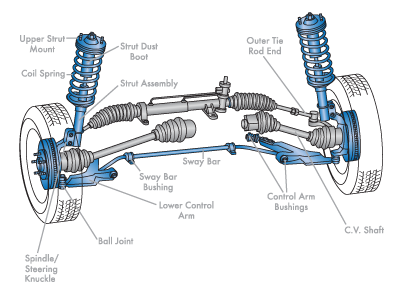
Suspension systems keep your ride smooth. Imagine driving in NYC with them bottoming out in our yet to be hatched pot holes or when you go over those giant metal plates that cover holes in the street made by Verizon, EPA and Con Edion? Struts and shocks keep you comfortable and safe by allowing your tires and brakes and tires to work as they were designed too.
Shocks:
Shock absorbers work to reduce your springs natural tendency to move back and forth. Pushing on a corner of your car and observing how many times the car bounces is a way to sort of test whether your shocks need replacing. Do-it-your-selfers, if you do the push down on the edge of your car test and it bounces more than twice chances are you need shocks. How often you need shocks varies because of driving conditions, tire conditions, road conditions, etc. which all impact the life of these parts and others.
More effective, accurate and safer way is to come on into any location of 106 St Tire & Wheel and get out 47 point safety inspection free.
Shocks are designed to contain fluid and internal passages to control the movement of the wheel and over time the fluid can leak or degrade. Its important that they are inspected for safety and all over functionality.
Springs:
Springs absorb the rocky energy of a bump or pothole hopefully without jarring the folks inside your car or damaging other parts of your ride. Most cars have 4 springs made from steel especially manufactured for autos and wound in a spiral shape. Made to last the lifetime of your ride, properly sized springs seldom need to be replaced.
Quick Struts by Napa:
Relatively new to the market, this something we recommend. While initially, the part is a little more money, the labor involved is less combining strut and spring functions in one part all with only one installation/labor charge. All of our locations can replace what you have with Napa Quick Struts. You can even book at appointment; give us a call at 718-446-6769.
Sway or Roll Bar:
When cornering the energy of the motion wants to roll your car's body to the outside of the turn especially if you turn on only two wheels. (that's a joke but we see some of you drive like that, we're not the cornering police but please keep in mind what we keep saying about NYC's driving conditions being "severe" in that...take a look at the people, the roads, the cars....UGH!) You feel this same force sitting inside the car. The sway bar works to counteract this force and helps to keep the inside wheel in contact with the ground. The stiffer the sway bar rates give a firmer ride and the better handling.
Ball Joints:
Your suspension is designed to move up and down with the road, it dips when you go over those school zone speed bumps, hits a pothole or one of Con Ed's famous metal plates that are put down a road is chopped up for water, electrical, FiOS installs, pipes, etc and road is re-black topped. Your motion is stabilized by control arms which are connected to the spindle by your ball joints. They are what they sound like... a ball and socket joint. They allow movement in two dimensions. Most modern day ball joints are lubricated with grease and are sealed. Older cars and trucks (some new ones need grease as well) have ball joints that have a grease fitting to allow adding grease and you are well advised to have that done as often as needed. It's a necessary part of maintenance.
Spindle:
The spindle serves as the center point for your wheel and rotor to rotate around. The spindle should remain as parallel to the ground as possible. Your suspension system is designed to keep as much of the tire in contact with the road as possible. Of note: the condition of your suspension can affect tire wear and tire wear can affect the integrity of your suspension. This is why we give free inspections of tires, suspension systems and other important systems in our 47 point safety inspection...and it's free. The whole idea of that is to find the flaws in your systems before they cost you a bundle.
part 2 to follow on Monday...
/p>